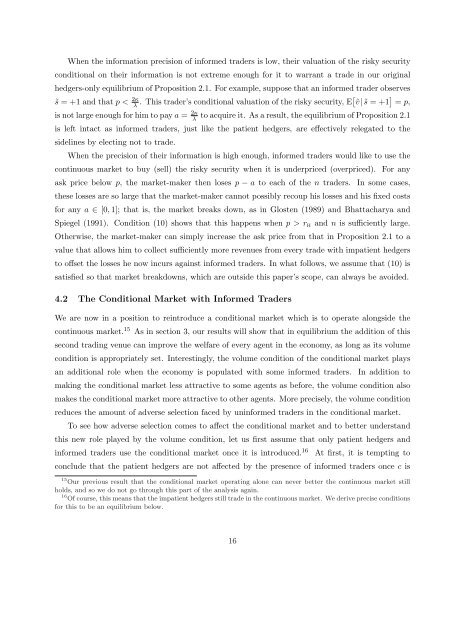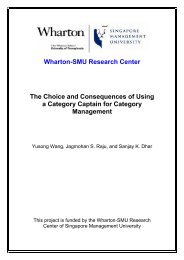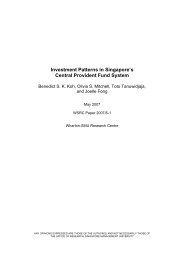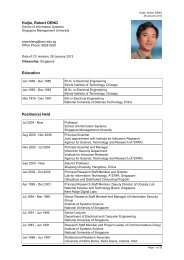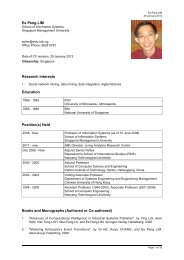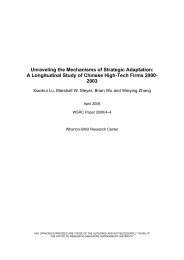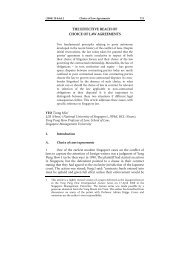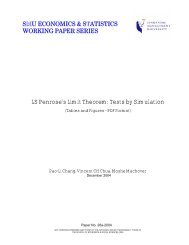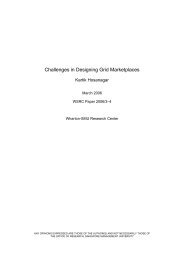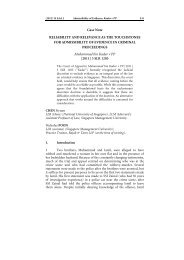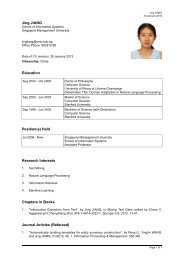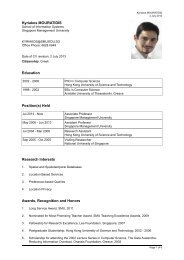The Benefits of Volume-Conditional Order-Crossing - Singapore ...
The Benefits of Volume-Conditional Order-Crossing - Singapore ...
The Benefits of Volume-Conditional Order-Crossing - Singapore ...
Create successful ePaper yourself
Turn your PDF publications into a flip-book with our unique Google optimized e-Paper software.
When the information precision <strong>of</strong> informed traders is low, their valuation <strong>of</strong> the risky security<br />
conditional on their information is not extreme enough for it to warrant a trade in our original<br />
hedgers-only equilibrium <strong>of</strong> Proposition 2.1. For example, suppose that an informed trader observes<br />
˜s = +1 and that p < 2κ<br />
λ . This trader’s conditional valuation <strong>of</strong> the risky security, E˜v | ˜s = +1 = p,<br />
is not large enough for him to pay a = 2κ<br />
λ to acquire it. As a result, the equilibrium <strong>of</strong> Proposition 2.1<br />
is left intact as informed traders, just like the patient hedgers, are effectively relegated to the<br />
sidelines by electing not to trade.<br />
When the precision <strong>of</strong> their information is high enough, informed traders would like to use the<br />
continuous market to buy (sell) the risky security when it is underpriced (overpriced). For any<br />
ask price below p, the market-maker then loses p − a to each <strong>of</strong> the n traders. In some cases,<br />
these losses are so large that the market-maker cannot possibly recoup his losses and his fixed costs<br />
for any a ∈ [0, 1]; that is, the market breaks down, as in Glosten (1989) and Bhattacharya and<br />
Spiegel (1991). Condition (10) shows that this happens when p > r H and n is sufficiently large.<br />
Otherwise, the market-maker can simply increase the ask price from that in Proposition 2.1 to a<br />
value that allows him to collect sufficiently more revenues from every trade with impatient hedgers<br />
to <strong>of</strong>fset the losses he now incurs against informed traders. In what follows, we assume that (10) is<br />
satisfied so that market breakdowns, which are outside this paper’s scope, can always be avoided.<br />
4.2 <strong>The</strong> <strong>Conditional</strong> Market with Informed Traders<br />
We are now in a position to reintroduce a conditional market which is to operate alongside the<br />
continuous market. 15 As in section 3, our results will show that in equilibrium the addition <strong>of</strong> this<br />
second trading venue can improve the welfare <strong>of</strong> every agent in the economy, as long as its volume<br />
condition is appropriately set. Interestingly, the volume condition <strong>of</strong> the conditional market plays<br />
an additional role when the economy is populated with some informed traders. In addition to<br />
making the conditional market less attractive to some agents as before, the volume condition also<br />
makes the conditional market more attractive to other agents. More precisely, the volume condition<br />
reduces the amount <strong>of</strong> adverse selection faced by uninformed traders in the conditional market.<br />
To see how adverse selection comes to affect the conditional market and to better understand<br />
this new role played by the volume condition, let us first assume that only patient hedgers and<br />
informed traders use the conditional market once it is introduced. 16 At first, it is tempting to<br />
conclude that the patient hedgers are not affected by the presence <strong>of</strong> informed traders once c is<br />
15 Our previous result that the conditional market operating alone can never better the continuous market still<br />
holds, and so we do not go through this part <strong>of</strong> the analysis again.<br />
16 Of course, this means that the impatient hedgers still trade in the continuous market. We derive precise conditions<br />
for this to be an equilibrium below.<br />
16


